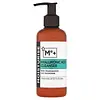Simple Skincare Protect 'N' Glow Express Glow Clay Polish Versus Superdrug Me+ Hyaluronic & Niacinamide Cleanser
What's inside
What's inside
 Key Ingredients
Key Ingredients

 Benefits
Benefits

 Concerns
Concerns

 Ingredients Side-by-side
Ingredients Side-by-side

Water
Skin ConditioningGlyceryl Stearate
EmollientGlycerin
HumectantCetearyl Alcohol
EmollientBentonite
AbsorbentSodium Lauryl Sulfoacetate
CleansingCocamidopropyl Betaine
CleansingCetyl Alcohol
EmollientBambusa Arundinacea Stem Extract
Skin ConditioningPEG-100 Stearate
Sodium Chloride
MaskingPhenoxyethanol
PreservativeCarbomer
Emulsion StabilisingTriethanolamine
BufferingSodium Sulfate
Ceteareth-20
CleansingPolysorbate 60
EmulsifyingDisodium EDTA
PEG-4 Dilaurate
EmulsifyingPEG-4 Laurate
EmulsifyingTocopheryl Acetate
AntioxidantSodium Ascorbyl Phosphate
AntioxidantIodopropynyl Butylcarbamate
PreservativePEG-4
HumectantZingiber Officinale Root Juice
Skin ConditioningWater, Glyceryl Stearate, Glycerin, Cetearyl Alcohol, Bentonite, Sodium Lauryl Sulfoacetate, Cocamidopropyl Betaine, Cetyl Alcohol, Bambusa Arundinacea Stem Extract, PEG-100 Stearate, Sodium Chloride, Phenoxyethanol, Carbomer, Triethanolamine, Sodium Sulfate, Ceteareth-20, Polysorbate 60, Disodium EDTA, PEG-4 Dilaurate, PEG-4 Laurate, Tocopheryl Acetate, Sodium Ascorbyl Phosphate, Iodopropynyl Butylcarbamate, PEG-4, Zingiber Officinale Root Juice
Water
Skin ConditioningCetearyl Alcohol
EmollientGlycerin
HumectantCeteareth-20
CleansingCetyl Alcohol
EmollientNiacinamide
SmoothingPhenoxyethanol
PreservativeBehentrimonium Methosulfate
Xanthan Gum
EmulsifyingTetrasodium Glutamate Diacetate
Ethylhexylglycerin
Skin ConditioningSodium Hyaluronate Crosspolymer
HumectantCitric Acid
BufferingSodium Lauroyl Lactylate
EmulsifyingPentylene Glycol
Skin ConditioningSodium Hydroxide
BufferingCeramide NP
Skin ConditioningCholesterol
EmollientCeramide AP
Skin ConditioningPhytosphingosine
Skin ConditioningCarbomer
Emulsion StabilisingCeramide EOP
Skin ConditioningWater, Cetearyl Alcohol, Glycerin, Ceteareth-20, Cetyl Alcohol, Niacinamide, Phenoxyethanol, Behentrimonium Methosulfate, Xanthan Gum, Tetrasodium Glutamate Diacetate, Ethylhexylglycerin, Sodium Hyaluronate Crosspolymer, Citric Acid, Sodium Lauroyl Lactylate, Pentylene Glycol, Sodium Hydroxide, Ceramide NP, Cholesterol, Ceramide AP, Phytosphingosine, Carbomer, Ceramide EOP
 Reviews
Reviews

Ingredients Explained
These ingredients are found in both products.
Ingredients higher up in an ingredient list are typically present in a larger amount.
Carbomer is a polymer of acrylic acid. Its main role is to create a gel consistency.
A high amount of carbomer can cause pilling or balling up of products. Don't worry, most products contain 1% or less of carbomer.
Ceteareth-20 is an emulsifier and cleansing agent. It is derived from cetearyl alcohol, a fatty alcohol.
As an emulsifier, Ceteareth-20 prevents oil and water from separating. It is also a surfactant. Surfactants help gather oil, pollution, and dirt to be washed away.
Cetearyl alcohol is a mixture of two fatty alcohols: cetyl alcohol and stearyl alcohol. It is mainly used as an emulsifier. Emulsifiers help prevent the separation of oils and products. Due to its composition, it can also be used to thicken a product or help create foam.
Cetearyl alcohol is an emollient. Emollients help soothe and hydrate the skin by trapping moisture.
Studies show Cetearyl alcohol is non-toxic and non-irritating. The FDA allows products labeled "alcohol-free" to have fatty alcohols.
This ingredient is usually derived from plant oils such as palm, vegetable, or coconut oils. There is debate on whether this ingredient will cause acne.
Due to the fatty acid base, this ingredient may not be Malassezia folliculitis safe.
Learn more about Cetearyl AlcoholCetyl Alcohol is a fatty alcohol. Fatty Alcohols are most often used as an emollient or to thicken a product.
Its main roles are:
Though it has "alcohol" in the name, it is not related to denatured alcohol or ethyl alcohol.
The FDA allows products labeled "alcohol-free" to have fatty alcohols.
Learn more about Cetyl AlcoholGlycerin is already naturally found in your skin. It helps moisturize and protect your skin.
A study from 2016 found glycerin to be more effective as a humectant than AHAs and hyaluronic acid.
As a humectant, it helps the skin stay hydrated by pulling moisture to your skin. The low molecular weight of glycerin allows it to pull moisture into the deeper layers of your skin.
Hydrated skin improves your skin barrier; Your skin barrier helps protect against irritants and bacteria.
Glycerin has also been found to have antimicrobial and antiviral properties. Due to these properties, glycerin is often used in wound and burn treatments.
In cosmetics, glycerin is usually derived from plants such as soybean or palm. However, it can also be sourced from animals, such as tallow or animal fat.
This ingredient is organic, colorless, odorless, and non-toxic.
Glycerin is the name for this ingredient in American English. British English uses Glycerol/Glycerine.
Learn more about GlycerinPhenoxyethanol is a preservative that has germicide, antimicrobial, and aromatic properties. Studies show that phenoxyethanol can prevent microbial growth. By itself, it has a scent that is similar to that of a rose.
It's often used in formulations along with Caprylyl Glycol to preserve the shelf life of products.
Water. It's the most common cosmetic ingredient of all. You'll usually see it at the top of ingredient lists, meaning that it makes up the largest part of the product.
So why is it so popular? Water most often acts as a solvent - this means that it helps dissolve other ingredients into the formulation.
You'll also recognize water as that liquid we all need to stay alive. If you see this, drink a glass of water. Stay hydrated!
Learn more about Water